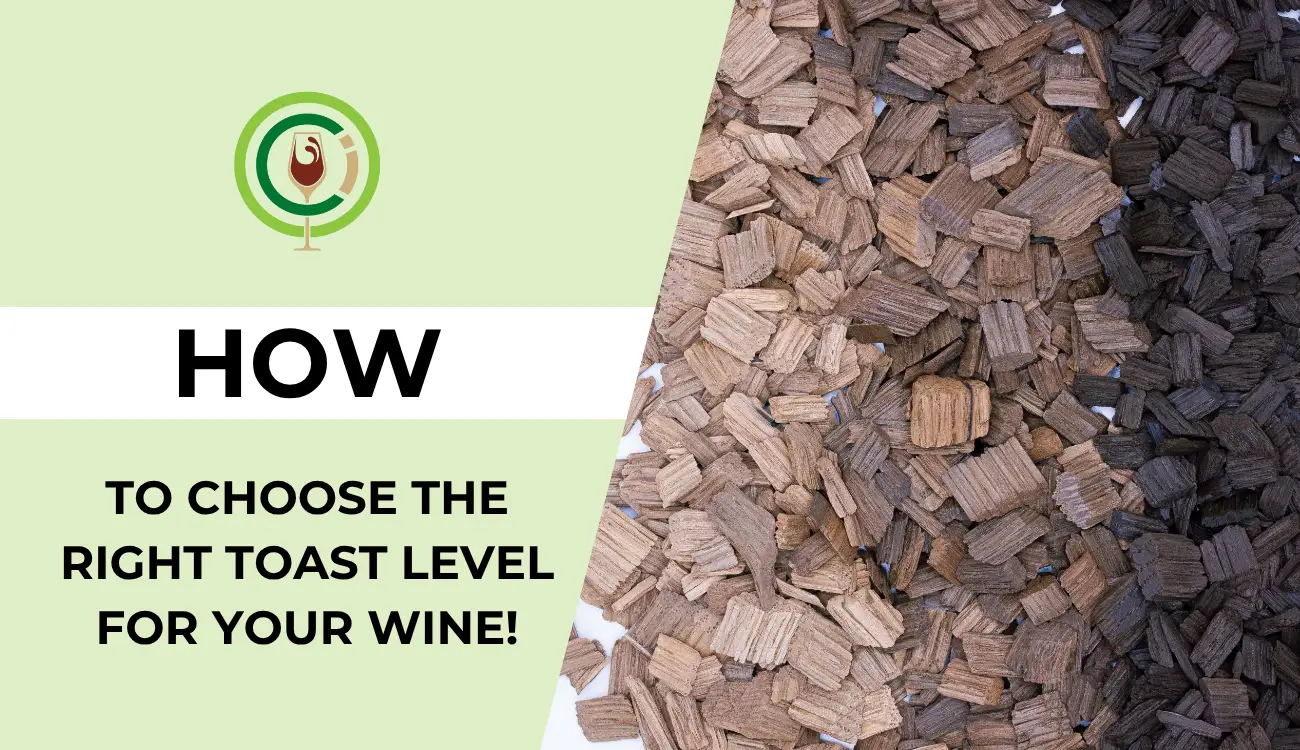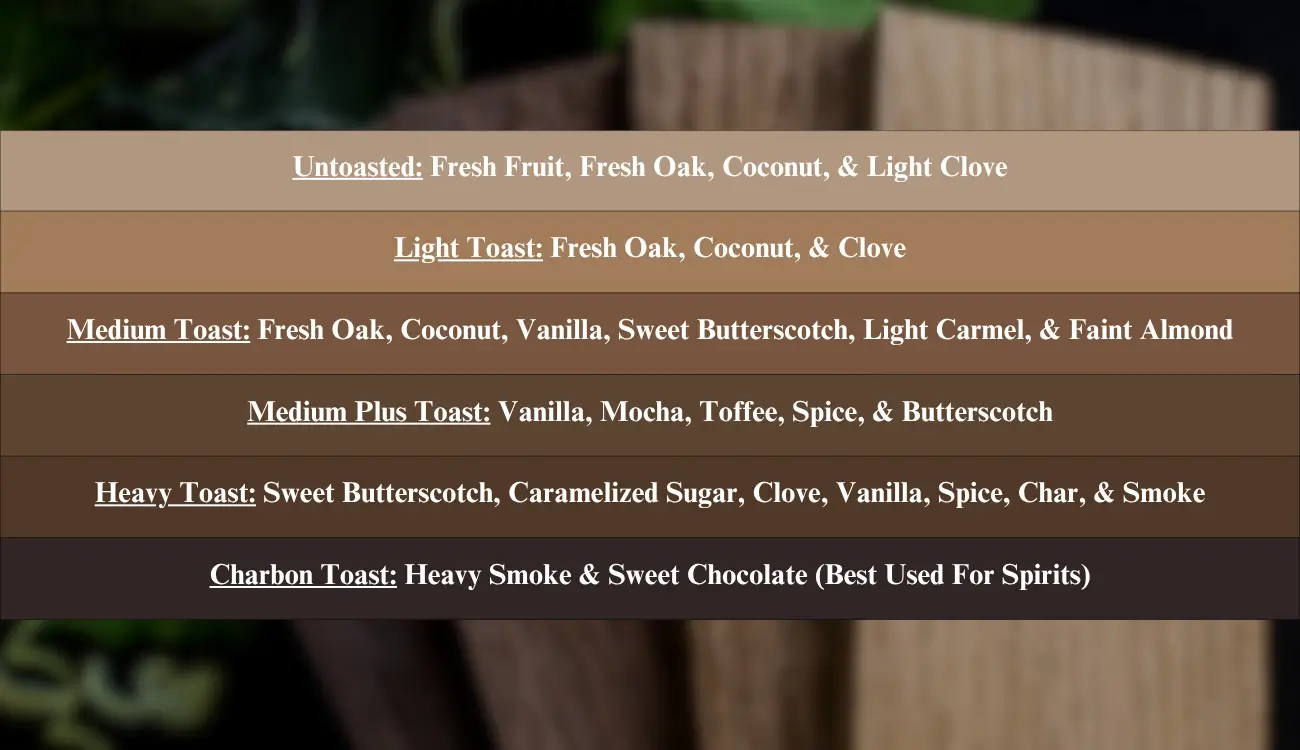How To Choose The Right Toast Level For Your Wine
7/16/25
Toasting, or roasting, oak is a crucial process that plays a pivotal role in shaping how oak influences a wine’s flavor, texture, and overall character. Whether it’s the delicate vanilla and fresh oak nuances from a medium toast or the rich butterscotch and smoky complexity imparted by a heavy toast, the level of toasting or roasting applied to oak—whether in barrels, chips, cubes, or other forms—can significantly impact the final profile of the wine.
The Science Behind Toasting
Toasting is the process of heating oak wood to specific temperatures to bring out different compounds, which in turn influences the flavors and aromas imparted to the wine. The heat breaks down lignins and tannins in the oak, releasing aromatic compounds such as vanillin (which imparts the familiar vanilla note) and lactones (which provide a buttery, coconut-like flavor). The degree of toasting controls the intensity of these flavors and the overall impact on the wine.
Toast levels range from untoasted to charbon, with each level contributing unique flavor profiles and mouthfeel. These levels are achieved by adjusting the duration and intensity of the toasting process. Light toasting results in a more delicate oak flavor, while heavier toasting produces more robust, smoky, and intense flavors.
Understanding Our Toast Levels
The toast levels offered vary company by company. At OCI, we currently offer six distinct toast levels that give winemakers flexibility and control over the oak influence on their wines. Each level imparts different flavors, aromas, and textures, depending on the type of oak and the desired effect on the wine.
Untoasted
Untoasted oak provides the most subtle influence on wine. Since the wood hasn’t been exposed to heat, it retains more of its natural wood characteristics, imparting a very gentle, neutral oak profile. Untoasted oak will contribute very light tannins, minimal flavor, and a slight textural influence, making it ideal for winemakers who want to preserve the wine’s natural fruit character without too much oak interference.
This level is perfect for wines that are already delicate or aromatic, such as Pinot Noir or Chardonnay, where the oak should remain a supporting background note rather than a dominant flavor.
Light Toast
Lightly toasted oak introduces subtle flavors such as vanilla, butter, and almond. The toasting process opens up the wood just enough to release these delicate notes while maintaining the wine’s freshness and fruitiness. This level is ideal for wines that benefit from a gentle oak influence, where light toast will add a touch of richness and complexity without overshadowing the wine’s natural characteristics.
Light toast is also perfect for more aromatic reds that need a soft enhancement without overpowering the wine’s delicate floral and fruit notes.
Medium Toast
Medium toast provides a more balanced oak influence. It imparts toasty, nutty, and spicy flavors, along with a gentle caramel or vanilla note. Medium toast oak is versatile and can be used in a wide range of wines. It adds a fuller, rounder texture to the wine while enhancing its complexity.
This level works particularly well for medium-bodied reds, where the oak can help create a smooth, balanced mouthfeel and enhance the wine’s overall depth without overpowering its natural flavors.
Medium Plus Toast
Medium Plus toast is slightly more intense, introducing richer spices, vanilla, and caramelized flavors. The oak’s influence becomes more pronounced, adding a touch of smoke and char that contributes to the wine’s complexity and body. Medium-plus toast is ideal for wines that already have a strong character, where the oak can elevate the overall profile without masking the natural fruitiness.
Heavy Toast
Heavy toast provides bold, intense flavors of roasted coffee, smoke, charred wood, and dark chocolate. The toasting process opens the oak up significantly, allowing it to impart deep, rich flavors and aromas. It’s perfect for wines that require more robust oak influence and a more intense flavor experience.
Charbon Toast
Charbon toast is the most intense level of toasting, where the oak is almost completely charred, producing powerful smoky, burnt, and charred wood notes. This extreme level of toasting imparts bold flavors of roasted coffee, smoke, ash, and spice. Charbon toast is perfect for winemakers who are looking for a very strong oak influence that adds complexity and depth. While charbon toast can be very impactful, it’s important to use it sparingly, as the intense flavors can quickly overpower a more delicate wine.
Which Toast Level Is Right For You?
Determining the right toast level depends on a few factors. Our experts have compiled a couple of factors that you must consider in order to choose your toast level.
Grape Varietals
Different grape varietals respond to oak in unique ways. Some grapes, like Pinot Noir, thrive with a light touch of oak, while others, such as Cabernet Sauvignon, benefit from bolder oak influences. Light and medium toasts work well with more delicate, aromatic grapes, whereas heavier toasts suit full-bodied, tannic varietals that can handle a robust oak presence.
Desired Oak Influence
Your choice of oak toast level should align with the intensity of oak influence you want in your wine. If you prefer a subtle oak character, go for a light or medium toast that adds gentle vanilla and almond notes. If you’re looking for a bolder oak presence, heavy and charbon toasts contribute more roasty, smoky, and spicy flavors that can complement full-bodied reds and wines with more structure. Understanding how much oak flavor you want in the final product will guide your selection.
Aging Potential
Oak plays a crucial role in the aging process. If you intend for your wine to age well over time, you’ll want to select an oak toast level that supports long-term aging. Heavy toasting helps with aging potential by contributing tannins and stabilizing color, making it ideal for wines meant to mature for several years. Conversely, lighter toasts are more suited for wines that are meant to be consumed young, allowing the fruit character to shine through.
Consumer Trends
For our commercial clients, when it comes to consumer preferences, understanding your audience is key. If your market enjoys bold, intense wines, they may prefer a more robust oak profile with heavier toasts. If they favor elegant, nuanced wines, lighter toasts will be more appealing. As a producer, understanding these preferences will help guide your oak selection to align with consumer expectations and ensure your wine meets market demand.
Wrapping Up
Mastering the nuances of oak toast levels is an invaluable skill for any winemaker, offering the ability to shape and refine your wine’s profile with precision. By carefully experimenting with different toast levels, you can craft wines that not only showcase your unique style and vision but also elevate the depth, complexity, and balance of each batch. Whether you’re seeking subtle oak influences for delicate whites or bold, robust flavors for full-bodied reds, understanding how oak affects flavor, texture, and aging potential is key to creating wines that truly stand out.
If you’re ready to discover the perfect oak for your next batch, visit our products page to explore our premium oak alternatives. Start experimenting today and take your winemaking to the next level!
Last Updated: July 16th, 2025.
About Oak Chips, Inc.
At Oak Chips Inc., we are a family-owned business dedicated to providing premium oak products that enhance the flavors and aromas of wines, spirits, and more. With a focus on quality and craftsmanship, our selection includes French and American oak cubes, chips, staves, barrel inserts, and more, all designed to elevate your winemaking experience.





